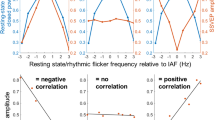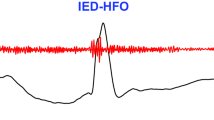Abstract
PATIENTS suffering from photosensitive epilepsy show generalized discharges in their electroencephalogram (EEG) during intermittent photic stimulation. In some patients, these discharges are preceded by occipital spikes, suggesting a focal onset. Hishikawa et al.1 have reported that the occipital spikes obtained in photo-sensitive epileptics have the same latency as some components of the visual evoked responses (VER), and suggested, that this might explain the origin of the occipital spikes in photosensitive epilepsy. The spikes were, however, obtained at flash rates of 10–16 s−1 (that is, the interval between the flashes was limited to a range of 63–100 ms) and the comparison of the occipital spikes was made not with the VER of the individual patient, but with VERs of a normal population. Further, the latencies for positive and negative components of the VER, as given by the authors, show a very wide range and in fact overlap. The relatively small interval between the flashes and the wide range of the VER components could result in a fortuitous relationship between occipital spikes and VER components. It has also been reported by Rodin et al.2 that spikes preceding generalized seizures, induced by ‘Megimide’ during intermittent photic stimulation, were related to normal VERs and consisted of a marked exaggeration of the secondary VER components. Their report, however, is concerned with normal animals (cats); and no details of the photic stimuli and the spikes are given. For these reasons we felt that we should re-examine the problem. The existence of a relationship between abnormal and “normal” responses would be critical to any theory attempting to explain the genesis of the occipital “epileptogenic” spikes.
This is a preview of subscription content, access via your institution
Access options
Subscribe to this journal
Receive 51 print issues and online access
$199.00 per year
only $3.90 per issue
Buy this article
- Purchase on SpringerLink
- Instant access to full article PDF
Prices may be subject to local taxes which are calculated during checkout
Similar content being viewed by others
References
Hishikawa, Y., Yamamoto, J., Furuya, E., Yamada, Y., Miyazaki, K., and Kaneko, Z., EEG Clin. Neurophysiol., 23, 320 (1967).
Rodin, E., Onuma, T., Wasson, S., and Porzak, J., EEG Clin. Neurophysiol., 27, 545 (1969).
Harding, G. F. A., Thompson, C. R. S., and Panayiotopoulos, C. P., Proc. Electro-physiol. Technol. Ass., 16, 159 (1969).
Jeavons, P. M., Proc. Electro-physiol. Technol. Ass., 16, 225 (1969).
Gastaut, H., and Regis, H., in Proc. Symp. Analysis of Central Nervous System and Cardiovascular Data using Computer Methods (edit. by Proctor, L. D., and Adey, W. R.), SP-72, 8 (National Aeronautics and Space Administration, Washington, 1964).
Author information
Authors and Affiliations
Rights and permissions
About this article
Cite this article
PANAYIOTOPOULOS, C., JEAVONS, P. & HARDING, G. Relation of Occipital Spikes evoked by Intermittent Photic Stimulation to Visual Evoked Responses in Photosensitive Epilepsy. Nature 228, 566–567 (1970). https://doi.org/10.1038/228566a0
Received:
Revised:
Issue date:
DOI: https://doi.org/10.1038/228566a0



